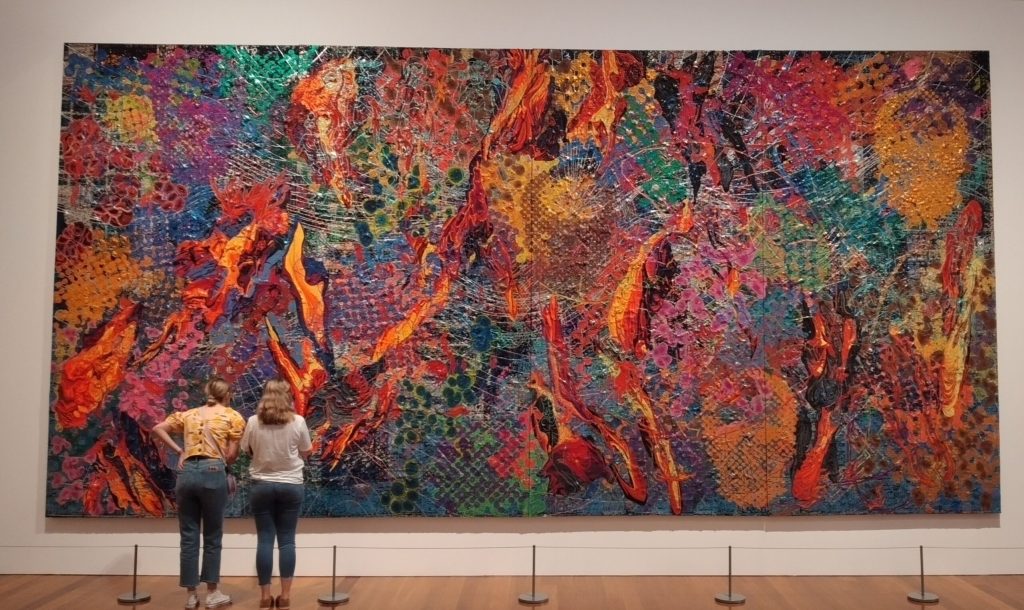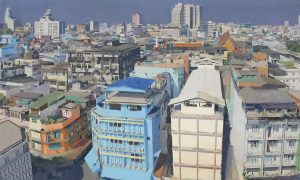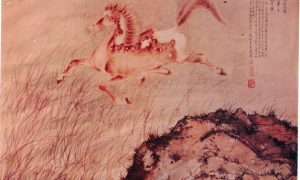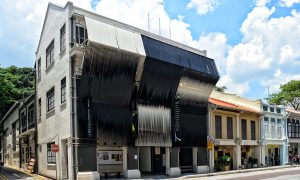The second of three articles on this major recurring exhibition by the author. Read the first here.
At the Queensland Art Gallery│Gallery of Modern Art (QAGOMA)’s 10th Asia Pacific Triennial, the central themes of art-futures and world-futures are showcased in an exciting selection of artworks from across the Asian and Pacific regions. Through the works of art featured by Southeast Asian artists in particular, there has been a keen interest in ideas of abstraction, where artists have used techniques in painting, printing, and three-dimensional form to converse on the pulse and beat of the world around us.
In each of these abstract paintings and prints, artists have layered their artworks with multiple registers and levels of meaning. Combining impressions, feelings and socio-political messages, artists have translated observations into patterns and rhythms that explore the textures of everyday life. From imagery inspired by the sound and atmosphere of an urban environment to visual articulations of the noise of domestic politics, what emerges from each artist’s use of abstraction is a keen interest in the process of communication: talking and translating through shapes and space and offering visualisations that are immersive and enveloping.
Reverberations
Digital technologies made for some fascinating curatorial inclusions and points of art-historical interest in the Triennial. In the tech-savvy times we are part, digital methods and materials are of increasing interest to contemporary artists as they explore and test the limits of machine learning, and reflect on local and global ideas through these mediums. One example is Genevieve Chua’s series of prints and small sculptures, Artificially Intelligent (2021), which plays not only with the artistic possibilities of computer algorithms, but also with ideas of logic and rhythm.
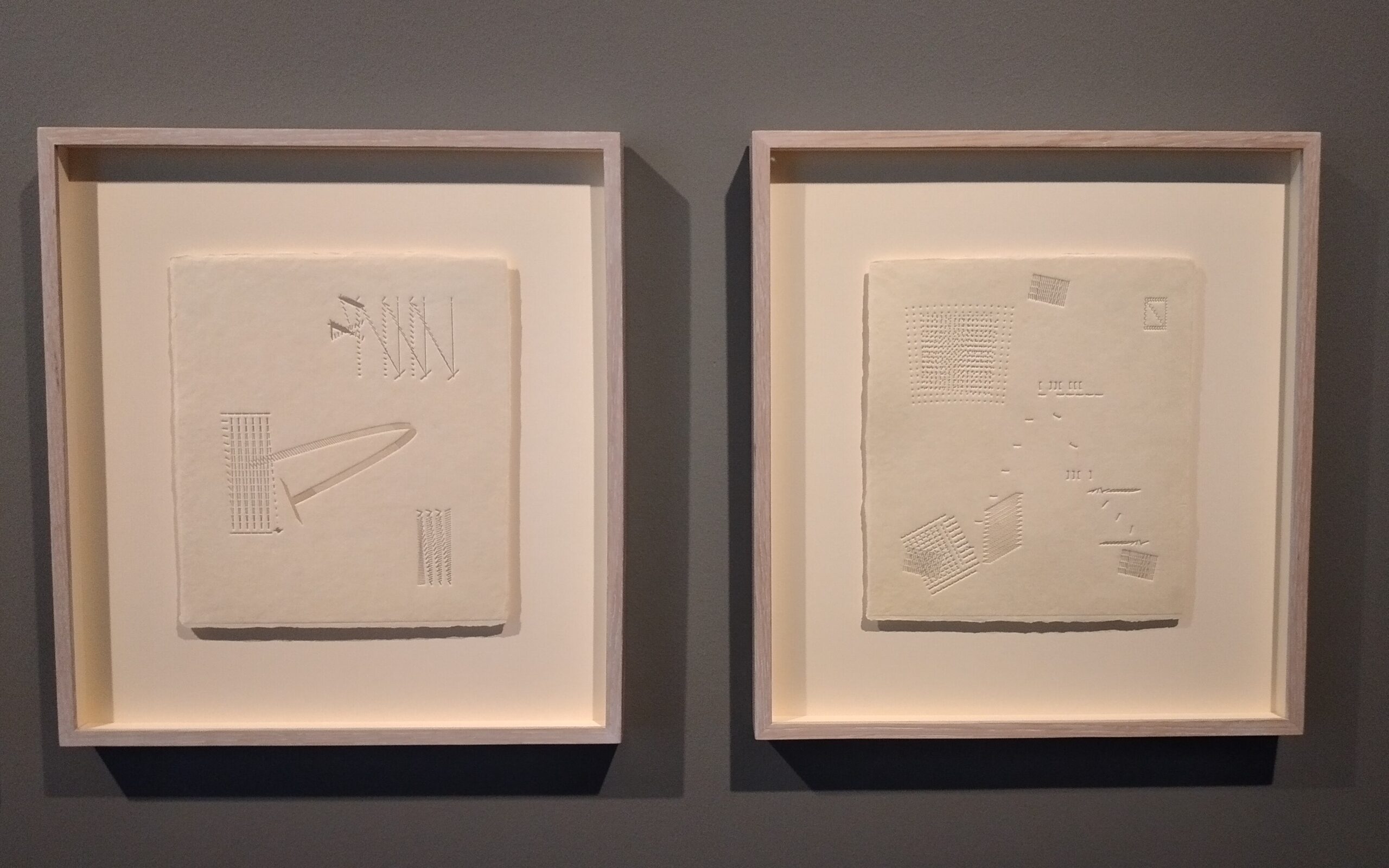
Genevieve Chua, Artificially Intelligent (2021), Relief print on paper: Laser engraved acrylic sheet, 45 x 41.3 cm (each)
Drawing on ideas of speech, notation, and the structures of machines, Chua’s prints and sculptures are comprised of patterns in punctuation—resembling the structure and shape of concrete poetry, but rerouting verse into non-verbal expressions. Separated from the logic of word and talk, the artist—via the computer—experiments with the formal and optical possibilities of symbols through the use of illustration software. In these cascading, pulsating explorations of dynamic movement and optical illusion, there is a “high tech” aesthetic to Chua’s prints; a feel and texture that hints at the ambience and city-sound of Singapore, an urban landscape that is an important source of inspiration to the artist’s practice.
In the use of embossing, a printmaking process where impressions are made in paper, Chua’s prints draw on a sense of tactility and touch; the artist is inspired by braille, the language of writing and communication for people who are blind. Through constant repetitions of punctuation it is possible to see how Chua has translated the ambience and feel of a futuristic city into a tactile, visual expression, and how this artwork communicates the patterns of urban environments. Slashes, brackets, full stops and punctuation marks hint at a particular and ever-changing “sound” of the city that is powered by technology and algorithms, a translation of the stammer, buzz and hum of metropolitan living into a two-dimensional visual code.
Refractions
Near the water mall at the Queensland Art Gallery hangs a selection of paintings by the Bandung-based artist, Syagini Ratna Wulan. Parhelion (2021) is one of these works of art; an immersive, large-scale, three-by-five-metre painting that shifts in a gradient of hues that shimmer, inviting viewers closer into the intricate structures of colour.
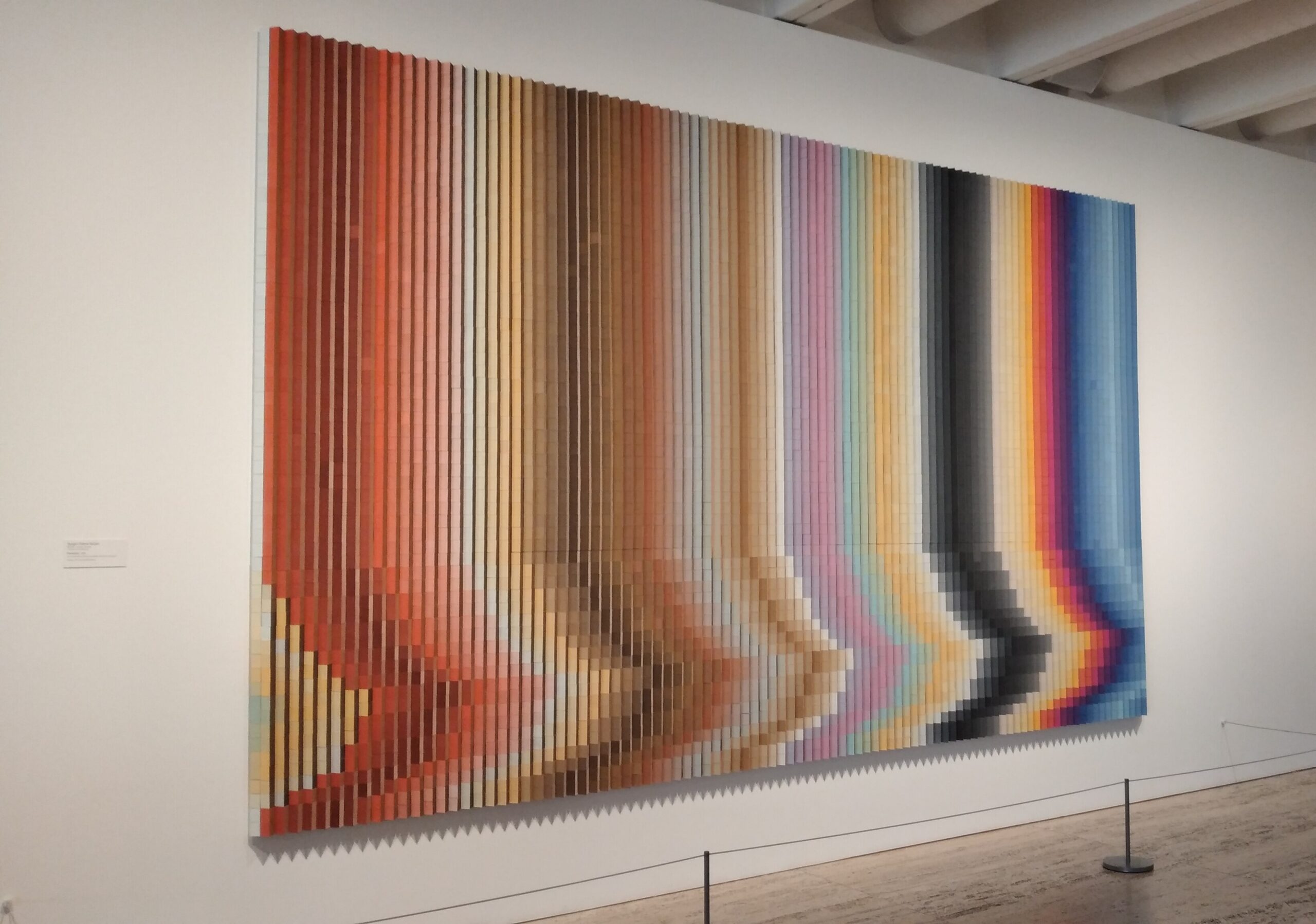
Syagini Ratna Wulan, Parhelion (2021), Painting: Acrylone butadine styrene plastic, stainless steel and lacquer paint. 300 x 500cm
The surface on which Syagini paints contains modular, dimensional, rectilinear forms. Using lacquer—which has a distinct shine—there is a feeling of visual trickery as the colour blocks progress through the spectrum, arranged on contrasting angles to create an illusory effect. Moving from one end of the painting to the other, the surface appears to move and wave with different viewpoints; creating a viewing experience that is grounded in ideas of interaction and optical play. Parhelion is a mathematically-minded work of art, exploring ideas of the kinetic and synthetic.
Syagini’s paintings draw on a broad spectrum of influences—for example, colour, geometry, and illusion—to examine the potentialities and (im)possibilities of artificial light and colour. Like Genevieve Chua, Syagini is also concerned with ideas of digital technology in art; in particular, with the presentation of natural and artificial colours, and how our perceptions and consumptions of both kinds of colour are mediated through digital screens. In Parhelion, there is a strong resemblance between the colour blocks in the artwork and the shape of pixels. Through the labour-intensive process of (re)making these forms in painting, Syagini challenges the push-pull tension between the virtual and the real; looking into the visual mechanisms that shape our world, and reflecting on the future(s) of these systems. In doing so, the artwork’s combination of curiosity and playfulness reflects thoughtfully the impacts of technology on the world we see.
Repetitions
Through the conversational, communicative qualities of abstraction, dimensions of the social and political contexts in which the artists operate are revealed. These qualities are most pronounced in Thasnai Sethaseree’s It’s unclearly clear, as yet incomplete (2017-2021), a triptych on display at GOMA. This series of paper collages makes use of bright colours and big surfaces. From a distance, there is a dazzling, brash quality to the work; one that draws you in to an immersive space that is equal parts sublime, distracting and confusing. Yet this is the intention of the artist: Sethaseree’s series is one that aims to unpack the alluring aesthetics and power of Thai domestic politics; exploring images of nationhood and “Thainess” through ideas of spectacle.
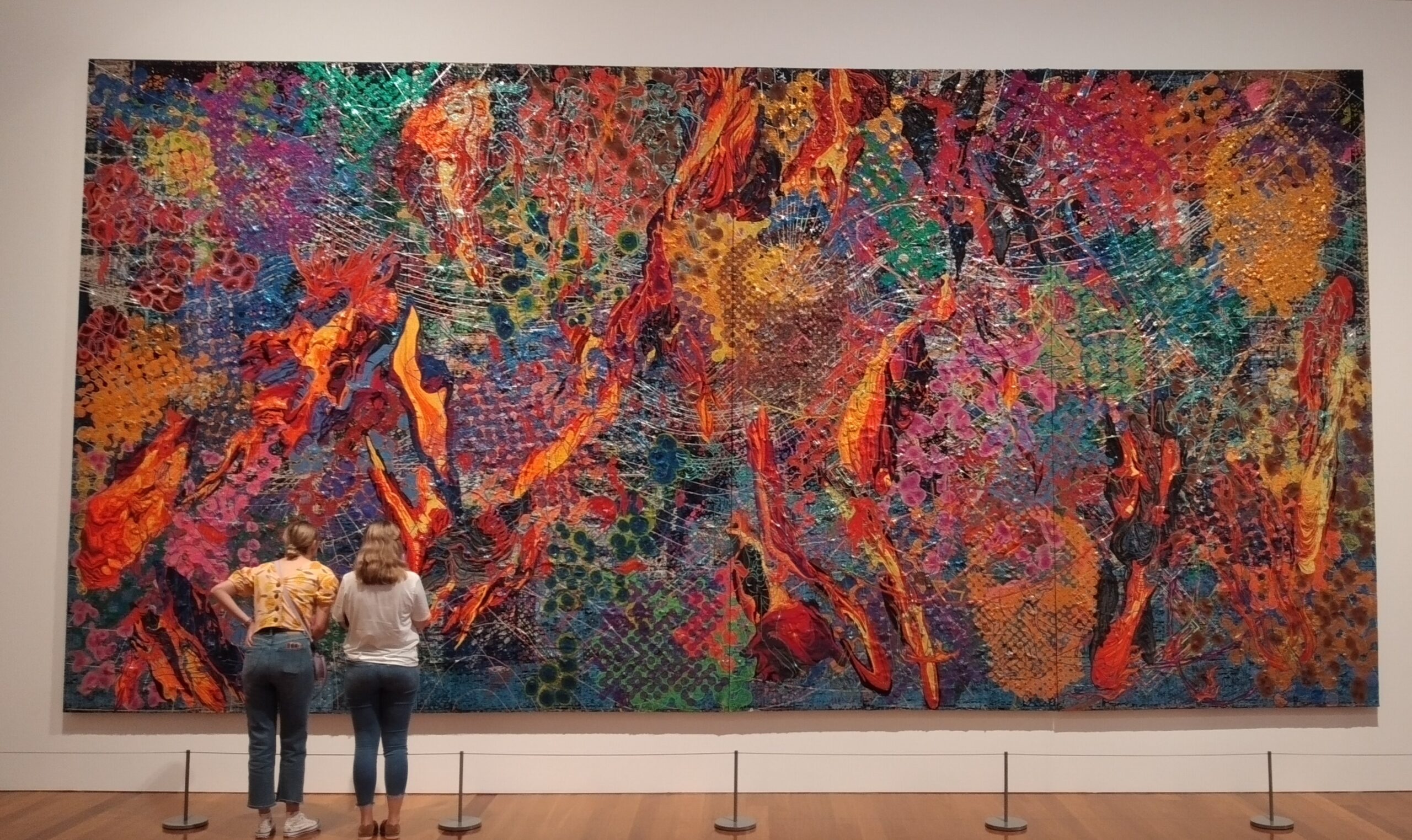
Thasnai Sethaseree, It’s unclearly clear, as yet incomplete (2017-2021). Paper collage: Buddhist monk robes, urethane, metal. Three parts: 400 x 800 cm (each)
Only when you move closer can you see that this collage is derived from real-life images: the “cosmos” in each artwork is situated in the skylines of urban Bangkok. The base layers of the three artworks (named ‘Heaven’, ‘Earth’ and ‘Hell’ respectively) are situated within three distinct financial districts of the city, but through the multilayering of patterns, lines, and images—including of biological forms, creatures, ghosts, skulls, and astronomical maps from the dates of significant political instability—there is constant repetition and replication, where the figurative elements give way to an artwork that takes on a distinctly abstract and fanciful quality.
There is an endless noise to the artwork; a constant crash and cacophony of colours that produce a feeling of discordance and doom. Nothing is clear, everything is suspended in bright patterns and complex layers. Through the placement of paper strips as lines and curves and layering of organic forms we can also see references to abstract expressionism and ‘drip painting’ that dominated the Western/American art worlds in the mid-twentieth century. These inferences take on particular significance through the material qualities and process of making the artwork: Sethaseree used local techniques of coloured paper cutting to critique these broader issues of national identity and corruption – made especially potent by the use of monk robes as the base of the artwork. Using these mediums in one artwork, the art-making process brings together inside and outside influences, demonstrating the distinct ways that Sethaseree has used the work to convey local contexts, but articulating these issues to the world.
Through the act of redrawing and collaging-over the top of prominent national locations – to the point that they are no longer discernible – It’s unclearly clear, as yet incomplete becomes an artwork that reroutes the noise of nationalism into semi-abstract form, doing so in a way that mocks and subverts the proponents of this ideology. In this way, Sethaseree reconfigures the boundaries between the representational and the non-representational in art; fusing both together into a work that is imaginative and interpretative.
Reflections
Another significant work of art is a series of acrylic paintings titled Kbach Teuk (Water Forms) (2021), by the Cambodian painter Than Sok,. Than’s Kbach Teuk paintings, which reimagine water patterns seen in Cambodian temples, have a much quieter and meditative energy than the works discussed above. They resonate through intricate patterns and a subtle gradient that moves from blues to greens, alternating between the two colours. Each artwork focuses on a different aspect of the natural world, transposed into a water design formation. Shrimps, freshwater dolphins, lotus flowers, river-hemp and water primrose are some examples of the artworks featured; rendered into delicate designs that ripple and flow across the picture plane.
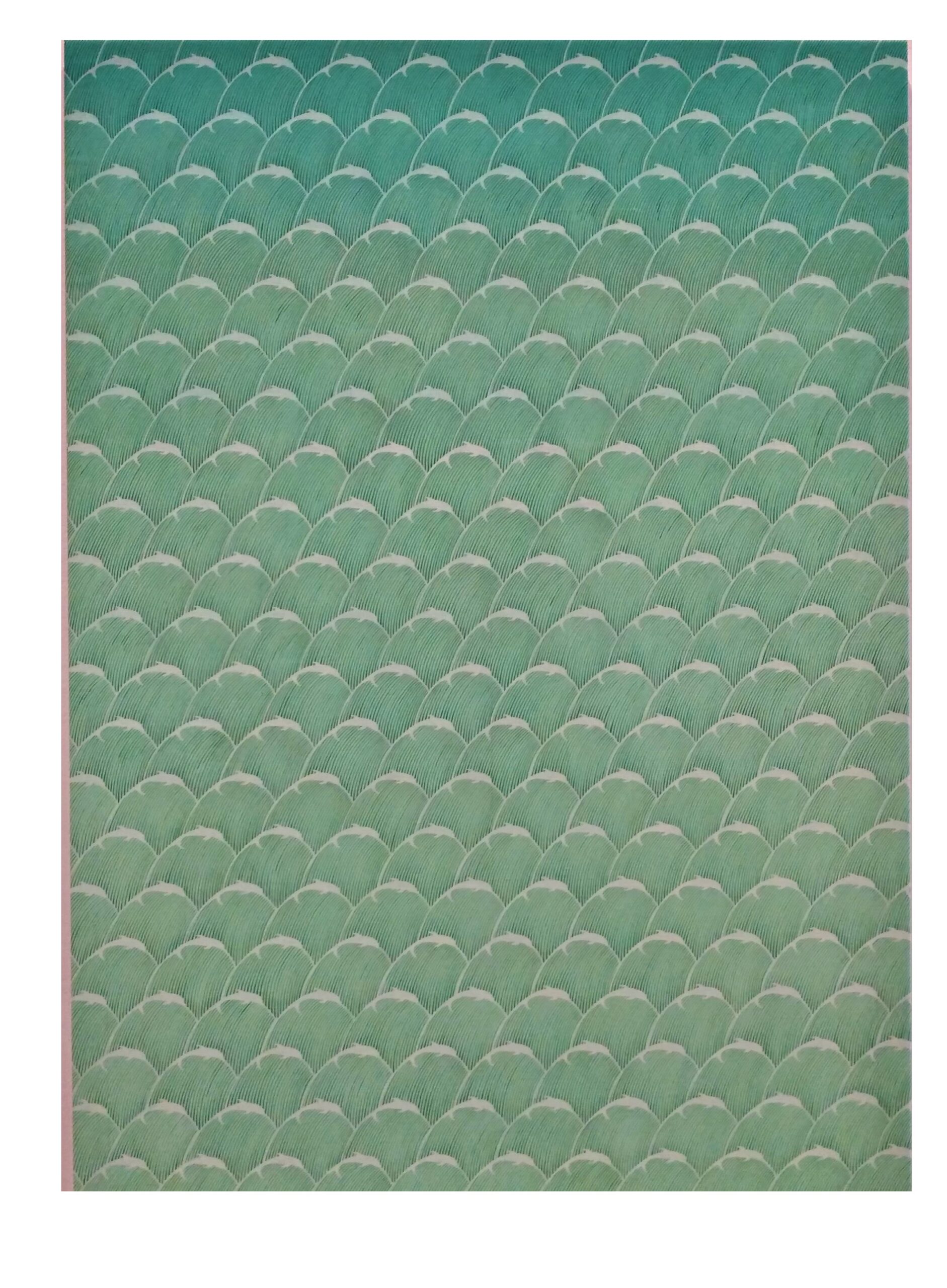
Than Sok, Kbach Teuk (Freshwater Dolphin Form) (2021). Synthetic polymer paint on canvas, 150 x 110cm
Across his practice, Than has been inspired by thoughts on Buddhism in contemporary Cambodia, and how religion has shaped perceptions of community and the environment. In this work, Than draws on ideas of relation and learning as he explores the natural world. This is especially evident through the way that his paintings facilitate a deep exercise in mesmeric slow looking, where the surface and textures encourage reflection and contemplation. In reinterpreting the structures of water, plants and fish in these abstract forms, Than draws attention to the importance of the environment to all of us, communicating the interdependence of water, plants and the animal kingdom, and the interconnectedness of us all within the broader ecosystem.
In the abstract works of art featured at APT10, artists have offered ways forward in thinking and communicating about issues in the contemporary moment, “translating” them into expressions that play with the limits of visuality and form. The way these concerns are articulated through visual, material and immersive qualities provides ways of looking at the world through multiple layers and multiple frameworks; conveying the importance and urgency of key issues and stories.
Artists have drawn from their local contexts to convey the movements of contemporary life, but though there might be local contexts within each work of art, these abstractions also transcend borders to explore issues that have relevance to us all: such as Syagini Ratna Wulan’s concern with ideas of perception in the digital world, and Than Sok’s concerns with water, the life-sustaining ingredient we all depend upon. In each of these artworks, the multisensory visions offered by the artists provide ways of “talking through art”, and illustrating and unearthing the textures of life in the world around us.
APT10 is showing at the Queensland Art Gallery / Gallery of Modern Art until the 24th of April. All images are provided by New Mandala.
 Facebook
Facebook  Twitter
Twitter  Soundcloud
Soundcloud  Youtube
Youtube  Rss
Rss 